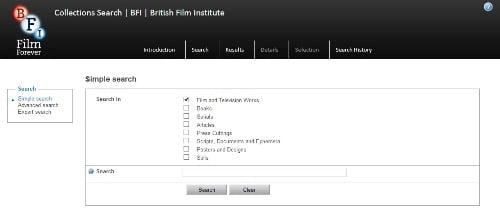
The British Film Institute has issued a new version of its database, which is a huge improvement on what has been available online before now. The new service, BFI Collections Search, for the first time combines its bibliographic, filmographic and technical databases, something the BFI has been trying to engineer for years (decades even). This means you can find out which of the 800,000 films and TV programmes on its database it actually holds, a feature not previously available to users outside its library and can find bibliographic references, again for the first time outside its library.
Add this to the subject searching which it introduced a year or so back, and it has become an immensely powerful and useful resource, particularly valuable for searching silent films on account of the large number of shotlists for early films created by its Archive in years past, and the extensive references to film trade journals, especially The Bioscope. Each record, in general, provides title, year of release, production company, credits, cast, synopsis (not all films will have one, please note), subject terms, references, and technical information where copies are held, with most names, companies and articles hyperlinked.
Tha main link takes you to the introduction. For searching, go to the Search link (http://collections-search.bfi.org.uk/web/search/simple). Search options are Simple, Advanced and (excitingly) Expert, which allows you to build up complex search enquiries using multiple fields e.g. to and from dates so you can search for date ranges. It has some oddities, so person searching is only available on the Advanced Search option (enter surname first) [Correction: You can search by name using Simple Search, but enter surname first]. Records come with a cine camera logo if they have a film, and the camera crossed through if they don’t (though I’ve noticed some instances where they say they don’t have a film, but I know that they do, so treat the information with caution). It always has been a database made up of primary sources (films they hold) and secondary sources (films they just have references to), and it has long been frustrating for researchers trying to tell one from the other. Now you can search using the Advanced option to see what specific materials they hold under each title, and where a viewing copy is available. The amount of technical information supplied is remarkable – by using the Advanced Search option you can, for instance, finding out how many 70mm films they hold (224) or all the film elements they hold for A Matter of Life and Death (45 master and 5 access copies on 35mm).
It helps a lot to know what you can expect to find, and as a service it’s aimed at the specialist. Those with a general interest in film wanting a short synopsis and nice pictures will be better served by the BFI’s general information search options, which is available from its front page or via http://search.bfi.org.uk. Those who may hanker for the old BFI database (without the technical information or article references) can still find it at http://old.bfi.org.uk/filmtvinfo.
Collection Search also provides access to the BFI’s huge book catalogue, serials catalogue, listing of articles, press cuttings list (names and subjects only, not the cuttings themselves, stills (images not online), posters and scripts. In each instance, the Advanced Search option is the best to use, particularly if you want to do name searching. All the physical library objects are held in its library on London’s South Bank, while the films – where a viewing copy exists – can be booked for viewing on site via the options given here.
A final feature that is really welcome is a search history option, so you can look back on all that you have searched on during one session, and follow the links back to the results.
You can only appreciate what Collections Search offers if you know the struggles that the BFI have had to bring together their different databases, with the filmographic and technical databases having been built long ago on different and stubbornly incompatible systems. Having the article references is also terrific to see. For years they were hidden from all users except those who visited the BFI’s library. Now there are not only the citations, but in some cases descriptions of the article’s contents. It’s wonderful to have so much rich and useful information all together in one place, and available worldwide. For someone who spent quite a few years of his working life adding information to this database (check out my epic shotlists for XIVth Olympiad – The Glory of Sport or The Open Road) there’s also a small element of nostalgic pride.
Go explore.
Wow, I remember talking to someone at BFI about the development of this data migration a few years back to get info for a job I was working on, never thought it would actually happen!
When I joined the National Film Archive at the BFI back in 1986 there was a system whereby every time a film element was examined, a paper record (called a ‘rough’) was produced, recording the film’s technical details. My job was to take these technical details and add them (by hand) to the filmographic catalogue in London. So the technical and the filmographic were brought together on a single record. A mere 27 years later, this can now be achieved electronically. Progress!